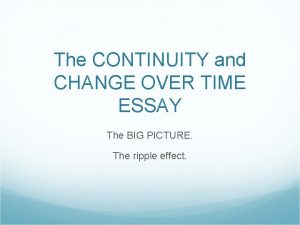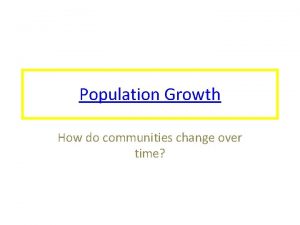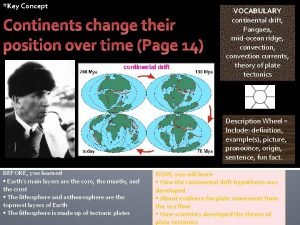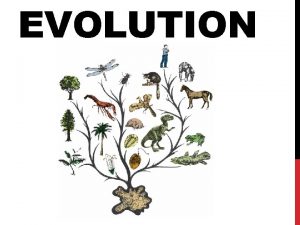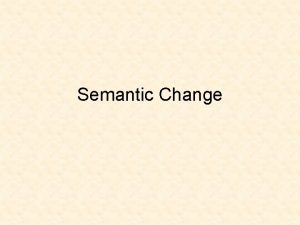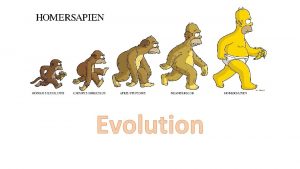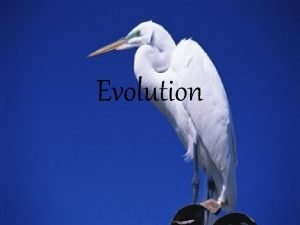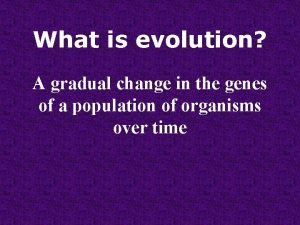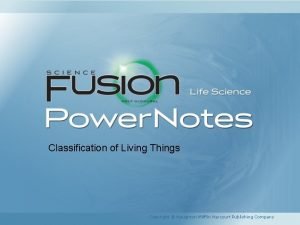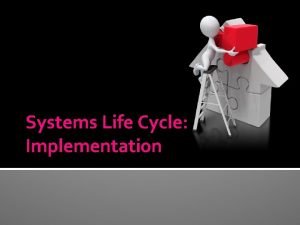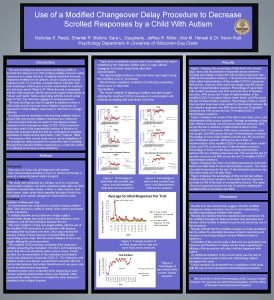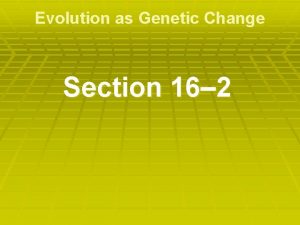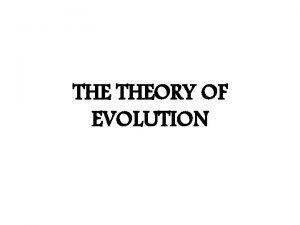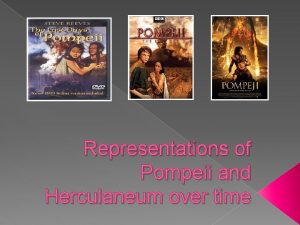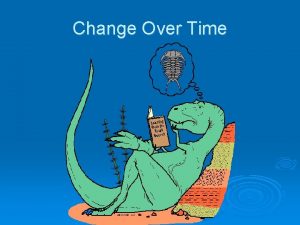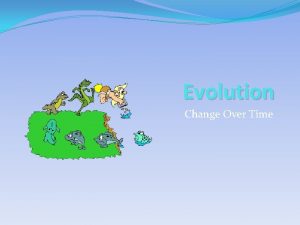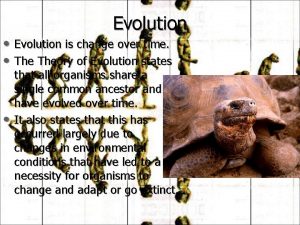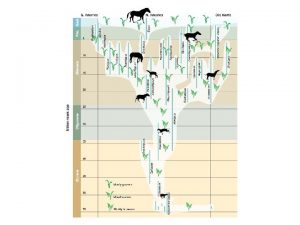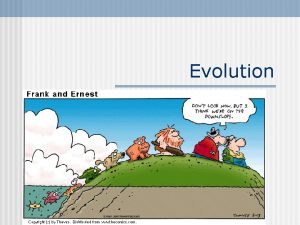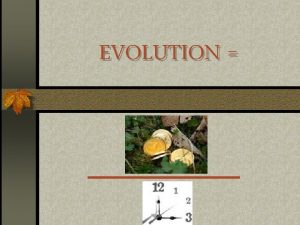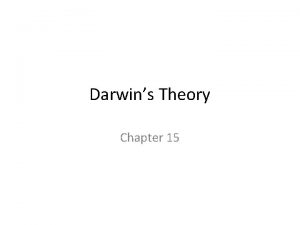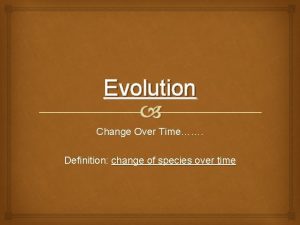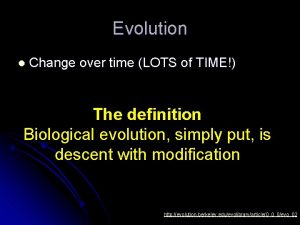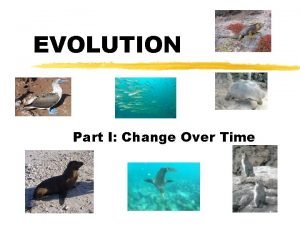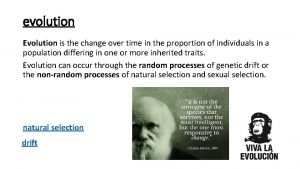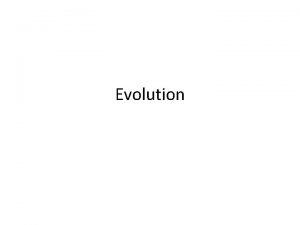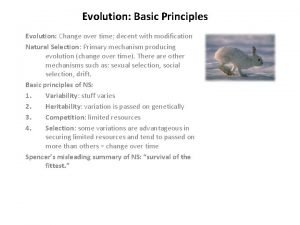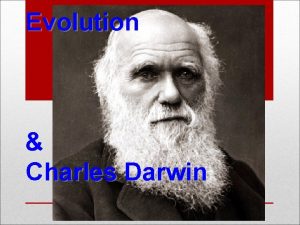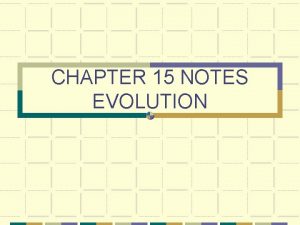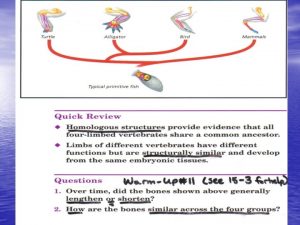Evolution Change over time Theory of Evolution A








































- Slides: 40

Evolution Change over time

Theory of Evolution A. Idea supported by scientific evidence (but no concrete experiments) over a long period of time B. Change in a species due to mutation of the DNA code that occurs over a long time

Meiosis/Mitosis Connection n Humans have 22 autosomal chromosomes and 1 sex chromosome (23 pairs of chromosomes total) in their sperm and egg cells. n It is on the 22 autosomal chromosomes that a mutation could occur

Who is Jean Lamarck? n n 1744 -1829 One of the first to acknowledge unifying modification He suggested that similar species came from a common ancestor This was evident in fossil records

Lamarck’s Theory n n n “Acquired traits” Use of structure results in evolution Does not take into account DNA or sex cell mutations

Lamarck’s Rejection His hypothesis was rejected, and easily disproved but, he was a forerunner of modern technology n He was the first to clearly state that types of organisms are a result of modifications over time n This idea was present more convincingly 50 years later n

Charles Darwin n 1809 -1882 n Known for two theories: n Decent with Modification n Modification by Natural Selection

Decent with Modification n All species have descended from one or a few “original “ types of life (common ancestor)

Natural Selection “Survival of the Fit” n Limiting Factors Include: n Environment n Climate n Competition Resources n Fit Reproduce n n Best adapted species will survive

Darwin’s key ideas: n n A. REPRODUCTION: Organisms produce more offspring than can survive B. VARIATION: Variety in traits exist C. SURVIVAL OF THE FIT: Some traits allow survival & are passed on D. Over time certain variations make up most of a population & they may be different from their ancestors

Theories of Evolution: Darwin: n Current theory n Natural Selection n “Survival of fit” n Reproduction of the best adapted species Lamarck: n “Acquired Traits” n Theory Abandoned n No knowledge of genetic traits or mutations in sex cells

ACTIVITY n Using the concept map Fill in as many words as you can at this moment… n Define each word: grab a Biology book to help you. n Take 10 minutes to do this n

Evolution Evidence: 1. Fossils 2. Adaptations 3. Comparative anatomy 4. Comparative Biochemistry 5. Comparative embryology 6. Plate Tectonics

What we are going to do: Over the next five days we will be looking at each one of these in depth. n This also means that we have an activity for the next five days n Some of these activities will be outside and you will be warned ahead of time! n

1. Fossil Evidence: n n Once living remains of organisms Limited: 1. 2. Type of material preserved (bone, shell, impressions, amber) Incomplete record

Plant Fossil Evidence:

Grand Canyon Lab n In groups of three you are to complete this lab activity. You have thirty minutes!

2. Adaptations: features suited to a particular environment that allow organisms to survive http: //wc. pima. edu/Bfiero/tucsonecology/adaptations_home. htm Inuit people, who live in the extreme cold of the Arctic, have short, stout bodies that conserve heat.

Masai people, who live in the arid lands of eastern Africa, have tall, lean bodies that disperse heat well.

Plant Adaptations: Help!!! Venus Fly Trap n Captures Animals n Acquires Minerals n For Photosynthesis

Leaf Adaptations: Succulents n Thick n Store Water n Prevent Drying out

Leaf Adapatations: Pine Needles n Shed snow n Less water loss n Reduced surface area n Tolerate wind

Flower Adaptations: Fly pollination: • Hair along petals • Putrid smell Bee pollination: • Smooth petal • Sweet smell

n n Examples of Adaptations Insecticides – Over the years many insects have become resistant to the type of insecticides we have been using. Why? n Species change – if a insect is susceptible to the insecticide they will die, the ones that are not survive and continue to reproduce.

n Round-Up Ready Crops – crops have been genetically engineered to be resistant to round up, allowing the spray to be used and not controlled by what it touches n These plants can get out in the wild or crossbreed creating “super plants” that can no longer be controlled

n Antibiotics – These are used to fight bacterial infections, but have become less successful in some cases. Why? n The bacteria that are susceptible die of, leaving on the strong ones to grow and multiple

What would you do? n Take the knowledge that you just learned, and explain in detail an adaptation you would want. Why would you want this adaptation? What draw backs could come about because of this adaptation? n At least 15 sentences

Wooly Worm Lab n Insects are a huge disturbance in agriculture. In this lab we will be looking at adaptations and natural selection in the dreaded wooly worm!

3. Comparative Anatomy: Structural similarities link related species

Comparative Anatomy Structures: Analogous: 1. Different ancestors 2. “ana”=different 3. Different underlying structures 4. Same Function 5. Similar Environments Homologous: 1. Same ancestor 2. “homo”=same 3. Same underlying structures 4. Different Functions 5. Different Environments

Analogous Structures n n Different underlying structures (different ancestors) Same function, similar environments Bird Wing Fly wing

Homologous Structures: Same underlying structures, different functions, different environments & common ancestor Bird Wing Porpoise Flipper

Comparative Anatomy Structures: n Vestigial Structures n n n Structures that are present, but not necessary These structures show a change has occurred over time Both whales and snakes have tiny leg like bones that are not visible or used showing that they evolved from animals that had legs

Cladogram Activity n How does a chart help teach us about anatomy?

4. Comparative Biochemistry n n Similar DNA sequences= Similar Gene segments of the DNA Code for similar traits In closely related species

Amino Acid Lab n To see how DNA sequences can be similar, but produce different animals…we will be looking at cladograms and DNA sequences together!

5. Comparative embryology: Similar embryo development in closely related species

Lets see how smart you are Each group has gotten a baggie that contains a number pictures of 4 different organism’s embryos at different stages. n Your job is to correctly place the stages for each organism. n

6. Plate Tectonics n Geological theory: n Continental masses were one land mass n Closely related species have common ancestors on now separated continents

Example: n Cattle: n Braham • Come from India n Hereford • Come from England n Both cattle are from a common ancestor and used for meat production, but they look different. This is because they evolved or changed due to their environment.
 Change and continuity essay example
Change and continuity essay example Why do communities change over time
Why do communities change over time A change of position over time
A change of position over time The gradual change in a species over time
The gradual change in a species over time Examples of pejoration
Examples of pejoration Coevolution
Coevolution The gradual change in living communities
The gradual change in living communities Variation natural selection definition
Variation natural selection definition Change in hereditary features over time
Change in hereditary features over time Gradual change
Gradual change Why do classification systems change over time?
Why do classification systems change over time? What is elapsed time
What is elapsed time Over the mountains over the plains
Over the mountains over the plains Siach reciting the word over and over
Siach reciting the word over and over Handing over and taking over the watch
Handing over and taking over the watch Parallel running implementation
Parallel running implementation Change over delay
Change over delay Section 16–2 evolution as genetic change
Section 16–2 evolution as genetic change Industry evolution and strategic change
Industry evolution and strategic change Model of evolution showing slow change
Model of evolution showing slow change Painting a wall physical or chemical change
Painting a wall physical or chemical change What are chemical changes
What are chemical changes Absolute change and relative change formula
Absolute change and relative change formula Two negative integers
Two negative integers Whats the difference between physical and chemical change
Whats the difference between physical and chemical change Decrease in supply vs decrease in quantity supplied
Decrease in supply vs decrease in quantity supplied Change in supply and change in quantity supplied
Change in supply and change in quantity supplied Change your water change your life
Change your water change your life Proactive and reactive change
Proactive and reactive change Chemical change and physical change
Chemical change and physical change Spare change physical versus chemical change
Spare change physical versus chemical change Rocks change due to temperature and pressure change
Rocks change due to temperature and pressure change Whats the difference between physical and chemical change
Whats the difference between physical and chemical change How does a physical change differ from a chemical change? *
How does a physical change differ from a chemical change? * Chemical change
Chemical change First and second order change in education
First and second order change in education Chopping wood physical or chemical
Chopping wood physical or chemical Climate change 2014 mitigation of climate change
Climate change 2014 mitigation of climate change Starbuck logo
Starbuck logo Alterations in various aspects of society over time
Alterations in various aspects of society over time Representations of pompeii and herculaneum over time
Representations of pompeii and herculaneum over time
